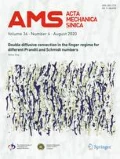Abstract
Large eddy simulation (LES) of low Mach number compressible turbulent channel flow with spanwise wall oscillation (SWO) is carried out. The flow field is analyzed with emphases laid on the heat transport as well as its relation with momentum transport. When turbulent coherent structures are suppressed by SWO, the turbulent transports are significantly changed, however the momentum and heat transports change in the same manner, which gives the evidence of inherently consistent transport mechanisms between momentum and heat in turbulent boundary layers. The Reynolds analogies of all the flow cases are quite good, which confirms again the fact that the transport mechanisms of momentum and heat are consistent, which gives theoretical support for controlling the wall heat flux control by using the drag reducing techniques.
Similar content being viewed by others
References
Stalio E., Nobile E.: Direct numerical simulation of heat transfer over ribles. Int. J. Heat Fluid Flow 24, 356–371 (2003)
Li F.C., Kawaguchi Y.: Investigation on the characteristics of turbulence transport for momentum and heat in a drag-reducing surfactant solution flow. Phys. Fluids 16(9), 3281–3295 (2004)
Jung W.J., Mangiavacchi N., Akhavan R.: Suppression of turbulence in wall-bounded flows by high-frequency spanwise oscillations. Phys. Fluids A 4(8), 1605–1607 (1992)
Laadhari F., Skandaji L., Morel R.: Turbulence reduction in a boundary layer by a local spanwise oscillating surface. Phys. Fluids 6(10), 3218–3220 (1994)
Baron A., Quadrio M.: Turbulent drag reduction by spanwise wall oscillations. Appl. Sci. Res. 55(4), 311–326 (1995)
Orlandi P., Fatica M.: Direct simulations of turbulent flow in a pipe rotating about its axis. J. Fluid Mech. 343, 43–72 (1997)
Dhanak M.R., Si C.: On reduction of turbulent wall friction through spanwise wall oscillations. J. Fluid Mech. 383, 175–195 (1999)
Quadrio M., Sibilla S.: Numerical simulation of turbulent flow in a pipe oscillating around its axis. J. Fluid Mech. 424, 217–241 (2000)
Choi J.I., Xu C.X., Sung H.J.: Drag reduction by spanwise wall oscillation in wall-bounded turbulent flows. AIAA J. 40(5), 842–850 (2002)
Huang, X., Xu, C., Cui, G.X., et al.: The influence of spanwise wall oscillation on the transportation of Reynolds stress. In: Proceedings of 2003’ Fluid Mechanics Youth Workshop, pp. 206–211. Xi’an, Shaanxi, China, 23–25 November, 2003
Huang W., Xu C.X., Cui G.X. et al.: Mechanism of drag reduction by spanwise wall oscillation in turbulent channel flow. Acta Mech. Sin. 36(1), 24–30 (2004) (in Chinese)
Quadrio M., Ricco P.: Critical assessment of turbulent drag reduction through spanwise wall oscillations. J. Fluid Mech. 521, 251–271 (2004)
Zhou, D., Ball, K.S.: The Mechanism of turbulent drag reduction by spanwise wall oscillation. In: Proceedings of 42nd AIAA/ASME/SAE/ASEE Joint Propulsion Conference and Exhibit, pp. 1–14. Sacramento California, USA. 9–12 July, 2006
Ricco P., Quadrio M.: Wall-oscillation conditions for drag reduction in turbulent channel flow. Int. J. Heat Fluid Flow 29(4), 891–902 (2008)
Trujillo, S.M., Bogard, D.G., Ball, K.S.: Turbulent boundary layer drag reduction using an oscillating wall. AIAA Paper: AIAA-1997-1870 (1997)
Choi K.S., DeBisschop J.R., Clayton B.R.: Turbulent boundary- layer control by means of spanwise-wall oscillation. AIAA J. 36(7), 1157–1163 (1998)
Choi K.S., Graham M.: Drag reduction of turbulent pipe flows by circular-wall oscillation. Phys. Fluid 10(1), 1–9 (1998)
Choi K.S., Clayton B.R.: The mechanism of turbulent drag reduction with wall oscillation. Int. J. Heat Fluid Flow 22, 1–9 (2001)
Cicca G.M.D., Iuso G., Spazzini P.G. et al.: Particle image velocimetry investigation of a turbulent boundary layer manipulated by spanwise wall oscillations. J. Fluid Mech. 467, 41–56 (2002)
Iuso G., Cicca G.M.D., Onoratob M. et al.: Velocity streak structure modifications induced by flow manipulation. Phys. Fluids 15(9), 2602–2612 (2003)
Ricco P., Quadrio M.: Wall-oscillation conditions for drag reduction in turbulent channel flow. Int. J. Heat Fluid Flow 29(4), 891–902 (2008)
Fang J., Lu L., Shao L.: Large eddy simulation of compressible turbulent channel flow with spanwise wall oscillation. Sci. China Ser. G 52(8), 1233–1243 (2009)
Martin M.P., Piomelli U., Candler G.V.: Subgrid-scale models for compressible large-eddy simulation. Theor. Comput. Fluid Dyn. 13, 361–376 (2000)
Ducros F., Laporte F., Souléres T. et al.: High-order fluxes for conservative skew-symmetric-like scheme in structured meches: application to compressible flows. J. Comput. Phys. 116, 114–139 (2000)
Kim J., Moin P., Moser R.: Turbulence statistics in fully developed channel flow at low Reynolds number. J. Fluid Mech. 177, 133–166 (1987)
Coleman G.N., Kim J., Moser R.D.: A numerical study of turbulent supersonic isothermal-wall channel flow. J. Fluid Mech. 105, 159–183 (1995)
Coleman, G. N.: Direct simulation of isothermal-wall supersonic channel flow. In: Annual Research Briefs, pp. 313–328. Center for Turbulence Research (1993)
Ringuette M., Wu M., Martin M.P.: Coherent structures in dns of turbulent boundary layers at Mach 3. J. Fluid Mech. 594, 59–69 (2008)
Morkovin, M.V.: Effects of compressibility on turbulent flows. In: Favre, A. (ed.) Mecanique de la Turbulence, pp. 367–380. CNRS, Paris (1962)
Bradshaw P.: Compressible turbulent shear layers. Annu. Rev. Fluid Mech. 9, 33–54 (1977)
Author information
Authors and Affiliations
Corresponding author
Additional information
The project was supported by Key Subjects of the National Natural Science Foundation of China (10732090), the National Natural Science Foundation of China (50476004), and the 111 Project (B08009).
Rights and permissions
About this article
Cite this article
Fang, J., Lu, LP. & Shao, L. Heat transport mechanisms of low Mach number turbulent channel flow with spanwise wall oscillation. Acta Mech Sin 26, 391–399 (2010). https://doi.org/10.1007/s10409-010-0343-6
Received:
Revised:
Accepted:
Published:
Issue Date:
DOI: https://doi.org/10.1007/s10409-010-0343-6




